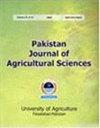盐度和干旱胁迫对土壤呼吸和微生物活动的交互影响
IF 0.6
4区 农林科学
Q3 AGRICULTURE, MULTIDISCIPLINARY
引用次数: 1
摘要
灌区干旱频率的增加和与盐渍化有关的问题可能直接影响土壤生物功能和土壤呼吸。为了阐明盐度和水分交叉胁迫对土壤呼吸和微生物活性的影响,设计了一项培养研究。在正常土壤(ECe=1.48 dS - m-1)和盐渍土壤(ECe=8 dS - m-1)中,维持了3种不同的水分水平:最佳水分条件(80%持水量)、中度干旱(50%持水量)和重度干旱胁迫(30%持水量)。结果表明,干旱胁迫导致土壤微生物生物量碳(MBC) (601+79 mg C kg-1)和累积碳- co2排放量(1153+96 mg C kg-1)显著增加(p < 0.05)。而在干旱胁迫下,除亮氨酸氨基肽酶活性显著升高外,其余细胞外酶活性均无显著差异。同样,盐渍条件下,MBC和土壤呼吸显著高于正常土壤。盐胁迫下细胞外酶活性也显著升高。相比之下,在干旱和盐度联合胁迫下,累积C- co2排放量显著降低(968+91 mg C kg-1土壤),这可以通过降低参与碳循环的β-葡萄糖苷酶活性来证明。相比之下,几丁质酶活性在联合非生物胁迫下增加,证实了微生物死生物量降解几丁质的有效性。综上所述,单独施用时,土壤微生物承受了干旱和盐胁迫,而盐和干旱联合施用限制了土壤微生物生物量和微生物活性。本文章由计算机程序翻译,如有差异,请以英文原文为准。
Interactive effects of salinity and drought stresses on soil respiration and microbial activities
Increasing frequency of droughts and problems related to salinization in irrigated areas may directly affect soil biological functions and soil respiration. An incubation study was designed to elucidate the effects of salinity and water intercross stresses on soil respiration and microbial activities. Three different moisture levels: optimum moisture conditions (80% water holding capacity (WHC)), moderate drought (50% WHC) and severe drought stress (30% WHC) were maintained in normal (ECe=1.48 dS m-1 ) and saline (ECe=8 dS m-1 ) soils. Our results showed that drought stress resulted in significant increase (p < 0.05) in microbial biomass carbon (MBC) (601+79 mg C kg-1 soil) and cumulative C-CO2 emissions (1153+96 mg C kg-1 soil). While under drought stress, extracellular enzyme activities showed no significant difference except leucine aminopeptidase with significant increase in its activity. Similarly, under saline conditions, MBC and soil respiration were significantly higher compared with normal soil. Extracellular enzyme activities were also significantly increased under salinity stress. In contrast, when combined stresses of drought and salinity were applied, cumulative C-CO2 emissions were significantly decreased (968+91 mg C kg-1 soil) as evident by decreased β-glucosidase activity, involved in C cycling. In contrast, chitinase activity increased under combined abiotic stresses, confirming the availability of chitin from microbial dead biomass degradation. It was concluded that microbes adopted drought and salinity stresses when applied individually but combined salinity with drought stress limited microbial biomass and microbial activities in soil.
求助全文
通过发布文献求助,成功后即可免费获取论文全文。
去求助
来源期刊

Pakistan Journal of Agricultural Sciences
AGRICULTURE, MULTIDISCIPLINARY-
CiteScore
1.80
自引率
25.00%
发文量
18
审稿时长
6-12 weeks
期刊介绍:
Pakistan Journal of Agricultural Sciences is published in English four times a year. The journal publishes original articles on all aspects of agriculture and allied fields.
 求助内容:
求助内容: 应助结果提醒方式:
应助结果提醒方式:


